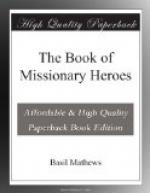The Baganda boys who had gathered round the White-Man-of-Work with wondering eyes, as he with his “magic” printed the sheets of paper, now crowded about him as he unrolled one of these white sheets with the curious black smudges on them. Mackay made the noise that we call A and then B, and pointed to these curious-shaped objects which we call the letters of the alphabet. Then he got them to make the noise and point to the letter that represented that sound. At last the keenest of the boys really could repeat the alphabet right through and begin to read whole words from another sheet—Baganda words—so that at length they could read whole sentences.
Two of these pioneer boys became very good scholars. One named Mukasa became a Christian and was baptised with the name Samweli (Samuel); another called Kakumba was baptised Yusufu (Joseph). A third boy had been captured from a tribe in the north, and his skin was of a much lighter brown than that of the Baganda boys. This light-skinned captured slave was named Lugalama.
Each of these boys felt that it was a very proud day when at last he could actually read a whole sheet of printing from beginning to end in his own language—from “Our Father” down to “the Kingdom, the power and the glory, Amen.”
One morning these page-boys leapt to their feet as they heard the familiar rattle of the drums that heralded the coming of King M’tesa. They bowed as he entered the hall and sat heavily on his stool, while his chiefs ranged themselves about him.
On a stool near the King sat Mackay, the White-Man-of-Work. His bronzed face was set in grim determination, for he knew that on that morning he had a difficult battle to fight.
Another loud battering of drum-heads filled the air. The entrance to the hut was darkened by a tall, swarthy Arab in long, flowing robes, followed by negro-bearers, who cast on the ground bales of cloth and guns. The Arab wore on his head a red fez, round which a coloured turban scarf was wound. He was a slave-trader from the coast, who had come from the East to M’tesa in Uganda to buy men and women and children to carry them away into slavery.
King M’tesa was himself not only a slave-trader but a slave-raider. He sent his fierce gangs of warriors out to raid a tribe away in the hills to the north. They would dash into a village, slay the men, and drag the boys and girls and women back to M’tesa as slaves. The bronze-skinned boy, Lugalama, was a young slave who had been captured on one of these bloodthirsty raids. And M’tesa, who often sent out his executioners to slay his own people by the hundred to please the dreaded and horrible god of small-pox, would also sell his people by the hundred to get guns for his soldiers.
The Arab slave-trader bowed to the earth before King M’tesa, who signalled to him to speak.
“I have come,” said the Arab, pointing to the guns on the floor, “to bring you these things in exchange for some men and women and children. See, I offer you guns and percussion caps and cloth.” And he spread out lengths of the red cloth, and held out one of the guns with its gleaming barrel.




